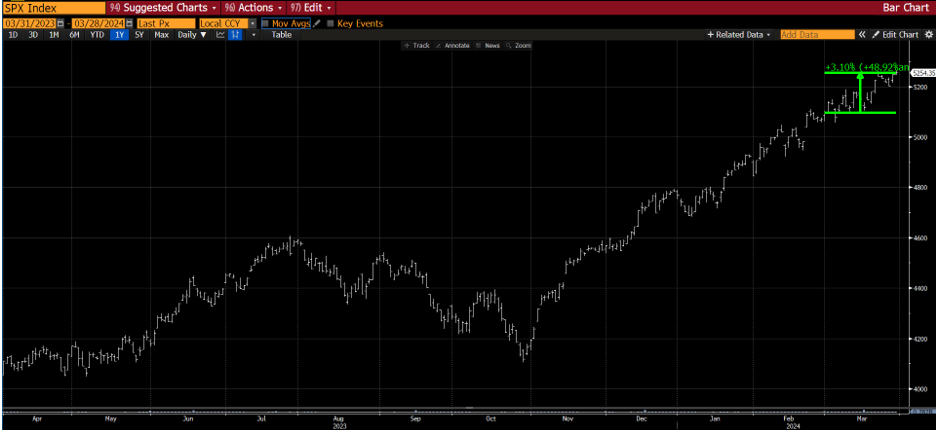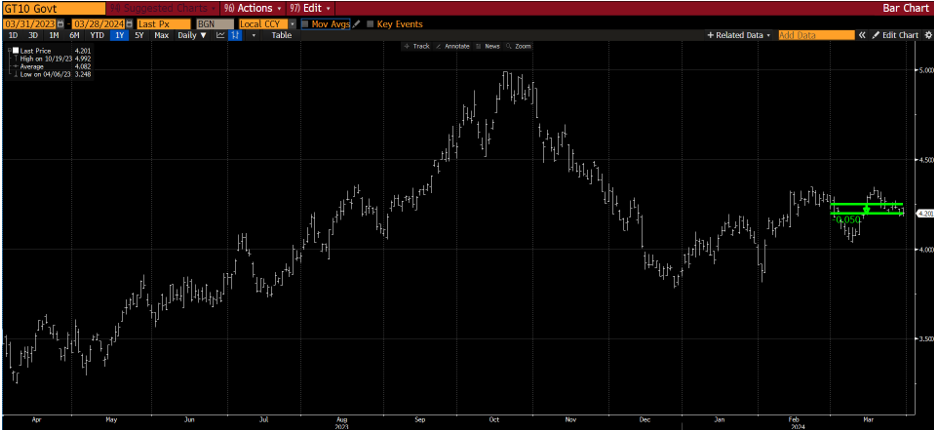Equities were up 3.1% in March, despite indications of higher inflation and hot payroll numbers that could cause the Fed to keep rates higher for longer.
Exhibit 1—Equities Up 3.1% in March

So, what kept hope alive? You have three guesses (and the first two don’t count). Yep, Jay Powell to the rescue! Despite a hot economy, two months of strong numbers and the potential for re-acceleration in inflation Fed Chair Jay Powell chose to ignore the unruly data points during the March Fed meeting presser. The Fed kept the 3 assumed cuts in the dot plot as well, matching the market’s expectations at the time. So much for being “data dependent”.
All this jawboning kept rates subdued during March. Ten-year U.S. Treasury yields fell 5 basis points.
Exhibit 2—Bond Yields Fell 5 Basis Points to 4.20%

But the plot thickens! On Friday, March 29th (after both bond and equity markets were closed for the month) Powell reversed course, indicating: “The economy is strong: We see very strong growth. There’s no reason to think that the economy is in a recession or is at the edge of one. That means that we don’t need to be in a hurry to cut.” Subsequently, U.S. Treasury 10-year bond yields shot up 15 basis points, and stocks have begun to wobble in early April.
Just an early April Fools’ joke? Perhaps, but Powell is no prankster. Possibly he has (finally) concluded that billions in fiscal stimulus through the (inaccurately named) Inflation Reduction Act, a federal deficit equivalent to 6.4% of GDP, and financial conditions near record (easy) levels is at odds with slowing the economy and keeping a lid on inflation.
Or perhaps Jay has figured out that while those in lower income brackets have suffered from inflation, the wealthy have been benefitting from inflated asset prices. Yes, inflation hurts, but not as much if you own equities and a house on leverage, purchased when rates were rock-bottom. Upper tax brackets have continued to spend, fueled by inflated assets. So, while the Fed inflates equity prices through promises of rate cuts, wealth-effect spending rolls on.
Meanwhile, all of the rise in equities year to date is driven by expansion in the multiple while earnings estimates for 2024 have declined from 10.7% expected growth to 9.9% growth.
Multiples expand when investors expect future growth. And the Fed’s signals about lower rates had fueled expectations of faster growth ahead. However, lately, growth estimates are starting to contract, and valuations are rich by historical standards. Eventually, there will be a reckoning: Either earnings need to re-accelerate, or valuations will contract.
Are we seeing the signs of the start of this trend? Two of the Magnificent 7 are starting to falter (Apple and Tesla). At some point, fundamentals will matter. Perhaps not yet. But if bond yields climb and earnings don’t re-accelerate, equities are at risk.
Are you interested in making portfolio changes or getting a more in-depth analysis? Contact Stableford today by calling 480.493.2300 or simply request a copy of our Market Blast.
This market commentary was written and produced by Stableford Capital, LLC. Content in this material is for general information only and not intended to provide specific advice or recommendations for any individual. All performance referenced is historical and is no guarantee of future results. All indices are unmanaged and may not be invested in directly. The views stated in this letter are not necessarily the opinion of any other named entity and should not be construed directly or indirectly as an offer to buy or sell any securities mentioned herein. Due to volatility within the markets mentioned, opinions are subject to change without notice. Information is based on sources believed to be reliable; however, their accuracy or completeness cannot be guaranteed. Past performance does not guarantee future results.
S&P 500 INDEX: The Standard & Poor’s 500 Index is a capitalization-weighted index of 500 stocks designed to measure the performance of the broad domestic economy through changes in the aggregate market value of 500 stocks representing all major industries.
